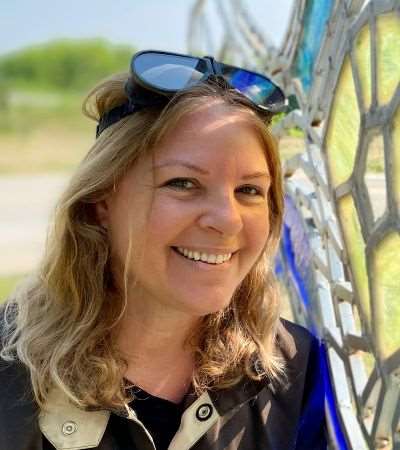Silent Stowaway or Trojan Horse
Research by Dr. Vera Tarakanova
Sculpture by Michelle Anomaly
Video by Alex Boyes and Dan Ollman
Soundtrack by Alex Boyes
While many mobile phones are tucked away in pockets or purses, chances are that anyone you meet in the US owns one even if it is hidden from your view. Although the technology is a mere 50 years old, it has spread far and wide with 19 of every 20 Americans possessing a mobile phone in 2018 according to a study by the Pew Research Center. People in the US also are carrying around a much more ancient invader at roughly the same rate.
Most individuals encounter the intrusive Epstein-Barr virus as children or teenagers since it is so ubiquitous and easily spread. Infected children generally experience few if any symptoms and parents generally don’t know that their child has picked up a lifelong infection with Epstein-Barr virus. However, when the virus is first acquired in adolescence or beyond, it can cause infectious mononucleosis, or mono. People typically recover relatively quickly from this once-in-a-lifetime condition once the Epstein-Barr virus has settled down after establishing its deep-rooted refuge in certain cells.
Within its human hosts, the virus typically hides away in a passive state. Stress to the body or changes in the immune system can cause Epstein-Barr virus to become much more active. This increase in activity is the first step towards cancer that is driven by Epstein-Barr virus in a small percentage of people. Although it is a rare event, because of how many people harbor lifelong Epstein-Barr viral infections, experts estimate that the virus is associated with approximately one percent of all cancers.
Vera Tarakanova, PhD, MCW professor of microbiology and immunology, studies gammaherpesviruses such as Epstein-Barr virus to better understand their interactions within their human hosts. Her goal is to better understand how the virus infiltrates and manipulates our immune systems to develop and maintain a lifelong infection, and whether the virus’s subterfuge contributes to the development cancer. If it does, investigating how this happens may provide clues to predicting who is at risk of suffering from a gammaherpesvirus-associated cancer so they can be monitored and treated as early as possible. This knowledge also may help scientists develop a way to prevent a gammaherpesvirus-associated cancer from forming.
Researcher Bio: Dr. Vera Tarakanova
.jpg)
Visit Dr. Tarakanova's Profile
Artist Bio: Michelle Anomaly

Visit the artist's website
Artist Statement: "Oops!"
I’m so grateful for this opportunity to create a visual interpretation of Dr. Vera Tarakanova’s research through Project Wonder: The Art of Science at MCW. This capsule represents a memory B cell. Inside of it you see a Sasquatch whose fur is made of old, bent, rusty nails. It represents the Epstein-Barr virus, and the spike proteins on its surface. The Sasquatch appears in myth as a mysterious, ancient creature. It is thought to be very good at hiding. The Epstein- Barr virus also is very capable of concealing itself from the human immune system. Most people have no idea that, at this very moment, it most likely is living in some of their white blood cells – in some of YOUR memory B cells! This virus has been hitching rides with humans for eons and about 95 percent of us are infected with it.
Sasquatches in stories don’t seem to cause much trouble, and this one probably spends most of his its time napping or staring up at the stars. The Epstein-Barr virus inside of you is probably doing the same thing, just chilling and hanging out without raising a ruckus. In this sculpture, however, we can clearly see that it has caused damage to its home. Why? Is it just too big and clumsy to live in his its glass house? Maybe it likes to dance on occasion and, this last time, it spun around and – with an “oops!” – poked a hole in the wall. Or maybe it is a cranky creature and keeps taking its frustrations out on its surroundings.
Dr. Tarakanova and her team investigate many questions concerning the Epstein-Barr virus. Why does it sometimes cause cancer? What are the triggers that cause it to damage our cells? Her work is important, and I really hope this visual interpretation piques your interest and leads to better understanding and appreciation of her research.



